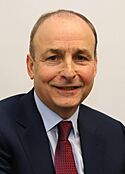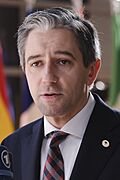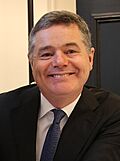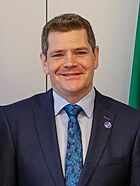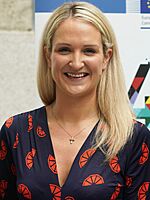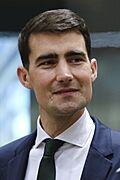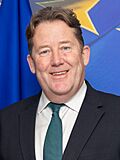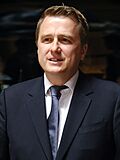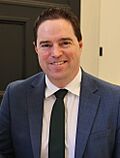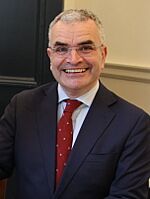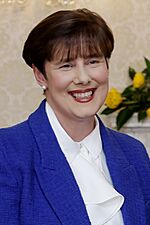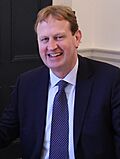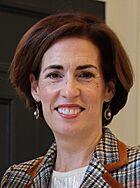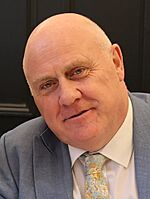Government of Ireland facts for kids
Quick facts for kids Government of Ireland |
|
|---|---|
| Irish: Rialtas na hÉireann | |
|
Central government
|
|
 |
|
| Overview | |
| Polity | Unitary parliamentary republic |
| Leader | Taoiseach (Micheál Martin) |
| Appointed by | President of Ireland (Michael D Higgins) on successful nomination from Dáil Éireann |
| Ministries | 18 (list) |
| Responsible to | Oireachtas Éireann |
| Annual budget | €10.5 billion (2024) |
| Headquarters | Government Buildings, Merrion Street, Dublin |
| Website | |
The Government of Ireland (called Rialtas na hÉireann in Irish) is the main group of people who run the country of Ireland. Think of it like the principal and teachers who manage a school, but for a whole country! It's led by the Taoiseach, who is like the head of the government.
The government is also known as the cabinet. It's made up of special members called ministers. Each minister must be a member of the Oireachtas, which is Ireland's parliament. The Oireachtas has two parts: Dáil Éireann (the House of Representatives) and Seanad Éireann (the Senate). Ministers usually lead a specific government department, like the Department of Education or Health.
The taoiseach is chosen by the Dáil from its members. Then, the president of Ireland officially appoints the taoiseach. The president also appoints the other ministers, after the taoiseach suggests them and the Dáil approves. The taoiseach also picks one minister to be the tánaiste, who is the deputy head of government. The taoiseach, tánaiste, and the Minister for Finance must all be members of the Dáil.
To make sure laws and budgets are passed, the government needs to have the support of most members in the Dáil.
The 35th government of Ireland started its work on January 23, 2025. Micheál Martin, the leader of Fianna Fáil, became the Taoiseach. Simon Harris, the leader of Fine Gael, became the Tánaiste. This government is a team-up, called a coalition government, between Fianna Fáil, Fine Gael, and some independent members of parliament. They formed this government after an election in December 2024.
Contents
How the Government Works
The rules for who can be in the government are set out in the Constitution of Ireland. The government must have between seven and fifteen members. All these members must also be part of the Oireachtas, Ireland's parliament.
Since 1966, most Irish governments have had the maximum of fifteen ministers. Sometimes, this number might be lower for a short time if a minister resigns or a party leaves a coalition.
Who Can Be a Minister?
Only two members of the government can come from the Seanad Éireann. All the others must be from the Dáil Éireann. The Taoiseach, Tánaiste, and Minister for Finance must always be members of the Dáil. Usually, all ministers are members of the Dáil.
Ministers who lead a government department are called 'Ministers of the Government'. There are also 'Ministers of State', sometimes called junior ministers. They help the main ministers in their departments but are not full members of the government. Sometimes, a 'minister without portfolio' is appointed. This person is part of the government but doesn't lead a specific department. The jobs of ministers can change, and sometimes old departments are closed, with their work moved to other departments.
Who Attends Cabinet Meetings?
Some people attend cabinet meetings even if they are not full members of the government. They can join in discussions but do not vote. The Attorney General is the government's legal advisor and attends meetings. The Chief Whip also attends. Sometimes, other junior ministers are invited to attend cabinet meetings to help with specific topics.
How Long Does a Government Last?
After a general election, a new Taoiseach is chosen by the Dáil Éireann and then appointed by the President. When the Taoiseach resigns, all other government members are also considered to have resigned. A new government is then formed. The Dáil can last for a maximum of five years. The Taoiseach can ask the President to end the Dáil early, which leads to a new general election.
The Taoiseach needs to keep the support of most members in the Dáil Éireann to stay in power. If the Taoiseach loses this support, they must resign. However, they can ask the President to dissolve the Dáil and call a new election. The President can choose whether or not to agree to this request.
The Taoiseach can ask the President to remove or accept the resignation of individual ministers. If the Taoiseach resigns, the whole government is considered to have resigned. However, the Taoiseach and other ministers continue their duties until new leaders are appointed.
When the Dáil is dissolved, ministers who were members of the Dáil stop being members of the Oireachtas. But the Constitution says that government members continue in their roles until new ones are appointed.
What Does the Government Do?
The Government of Ireland is the main decision-making body in Ireland. This means they have the real power to run the country. They are responsible for making sure laws are followed and that the country's services work well.
The government's power has some limits. For example, the country cannot declare war or join a war without the Dáil's approval. But if there is an "actual invasion," the government can take any steps needed to protect Ireland.
All government ministers are responsible for the government's actions as a team. Each minister is also responsible for what happens in their own department. Even if a minister doesn't know every small detail, they are still in charge of their department's actions.
A Look Back: History of the Government
Before Ireland became fully independent, there was a group called the Ministry of Dáil Éireann from 1919 to 1922. After a special agreement in 1922, a Provisional Government was set up.
When the Irish Free State became independent on December 6, 1922, these groups were replaced by the Executive Council of the Irish Free State. Then, on December 29, 1937, when the Constitution of Ireland began, this council became the First Government of Ireland.
Since 1989, most governments in Ireland have been coalitions. This means two or more political parties work together to form the government. The first coalition government was formed in 1948. Usually, the Taoiseach is the leader of the biggest party in the coalition.
People Who Work for the Public
The public service in Ireland includes all the people who work for the government and public organisations. As of late 2024, there were over 408,000 people working in the Irish public service. These workers are divided into seven main areas.
Different Public Service Jobs
The public service includes people working in:
- The civil service (who help run government departments)
- The defence sector (like the army and navy)
- The education sector (teachers and school staff)
- The health sector (doctors, nurses, and hospital staff)
- The justice sector (police and court staff)
- Local authorities (people who run local councils)
- Non-commercial state agencies (organisations like Bord Bia or IDA Ireland)
Some large state-owned companies, like RTÉ (broadcasting) or ESB Group (electricity), are not part of the public service.
The biggest part of the public service is the health sector, with over 148,000 employees. The education sector is next, with about 134,000 employees.
| Sector | Employees |
|---|---|
| Civil Service | 52,793 |
| Defence Sector | 7,903 |
| Education Sector | 134,556 |
| Health Sector | 148,265 |
| Justice Sector | 14,080 |
| Local Authorities | 32,372 |
| NCSA | 18,922 |
| Total | 408,895 |
The Civil Service
The civil service helps the government carry out its work. It is made up of two main parts. Civil servants are expected to be fair and not take sides in politics. Some parts of the civil service work completely independently from government decisions.
Meet the Current Government
Micheál Martin was nominated as Taoiseach by Dáil Éireann on January 23, 2025. He was then appointed by the President. Martin chose the government members, and after the Dáil approved them, the President officially appointed them.
| Government ministers | |||||
|---|---|---|---|---|---|
| Office | Name | Party | |||
|
|
Taoiseach | Micheál Martin | Fianna Fáil | ||
|
|
Tánaiste Minister for Foreign Affairs and Trade Minister for Defence |
Simon Harris | Fine Gael | ||
|
|
Minister for Finance | Paschal Donohoe | |||
|
|
Minister for Enterprise, Tourism and Employment | Peter Burke | |||
|
|
Minister for Health | Jennifer Carroll Macneill | |||
|
|
Minister for Education and Youth | Helen McEntee | |||
|
|
Minister for Public Expenditure, Infrastructure, Public Service Reform and Digitalisation |
Jack Chambers | Fianna Fáil | ||
|
|
Minister for Climate, Energy and the Environment Minister for Transport |
Darragh O'Brien | |||
|
|
Minister for Housing, Local Government and Heritage | James Browne | |||
|
|
Minister for Agriculture, Food and the Marine | Martin Heydon | Fine Gael | ||
|
|
Minister for Culture, Communications and Sport | Patrick O'Donovan | |||
|
|
Minister for Further and Higher Education, Research, Innovation and Science |
James Lawless | Fianna Fáil | ||
|
|
Minister for Social Protection Minister for Rural and Community Development and the Gaeltacht |
Dara Calleary | |||
|
|
Minister for Children, Disability and Equality | Norma Foley | |||
|
|
Minister for Justice, Home Affairs and Migration | Jim O'Callaghan | |||
| Also attending cabinet | |||||
|
|
Government Chief Whip Minister of State at the Department of Health |
Mary Butler | Fianna Fáil | ||
|
|
Minister of State at the Department of Children, Disability and Equality |
Hildegarde Naughton | Fine Gael | ||
|
|
Minister of State at the Department of Agriculture, Food, Fisheries and the Marine |
Noel Grealish | Independent politician (Ireland) | ||
|
|
Minister of State at the Department of Transport | Seán Canney | |||
See also
 In Spanish: Gobierno de Irlanda para niños
In Spanish: Gobierno de Irlanda para niños



